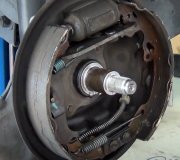I think you'll have four lines coming out of the master cylinder so you'll have to adjust this procedure to suit your needs. I don't have enough time left in my life to retype the entire description, so here's a copy and paste version that I gave someone for a Chrysler product:
Two nuts hold it to the power booster and two steel lines must be removed by unscrewing two soft brass nuts. To prevent rounding off the soft nuts, use a line wrench, also called a "flare-nut" wrench. It grips the nut on more sides than the regular open end wrench.
Be sure to follow the instructions for bench-bleeding the new master cylinder. Here's a trick that works on Chrysler products to prevent the need to bleed at the wheels. Loosen the two line nuts just a little, THEN unbolt the master cylinder from the power booster. Pay very close attention to the steel lines as you turn the nuts to be sure they're not twisting. If the nuts don't spin freely, the lines will twist and snap off. Then you have another repair to do that involves new fittings and making double flares. Double flares are hard enough for a professional. They're harder to do in the confines of the engine compartment. Pull the master cylinder forward off the mounting bolts, then use it as a handle to twist the two lines upward just enough so those first two inches are not parallel to the ground. Then you can remove the lines. This will prevent the brake fluid from running out of them. Be careful to not drip brake fluid on the car's paint.
After bench bleeding the new master cylinder, leave the reservoir at least half full of fluid. When you install it, you will have to tilt it to line up the ports with the line nuts. Remove one plastic bench-bleeding fitting, then install the steel line nut hand tight. While you do this, fluid will be dripping out, keeping the line and port full. If the nut doesn't thread in easily by hand, it's cross-threaded. Start over and try again until the nut goes in by hand, typically four or five revolutions. If you damage the threads in the aluminum ports, there will be no warranty and you will have to buy another master cylinder.
Once the first line is connected hand tight, do the same thing with the second line. When both fittings are hand tight, twist the master cylinder and lines back down to their normal position, and bolt it to the booster. You'll need a helper for the next step. There will be a little air in the ports and tops of the lines. Tighten the front nut, then loosen the REAR nut about a quarter turn, then have your helper push the brake pedal down very slowly. It should take him about 15 seconds to push it half way to the floor. Any faster, and the air might still get forced down the lines. While the pedal is moving down, you will see air bubbles coming out around the nut's threads. When the bubbles stop appearing, tighten the nut. Tell your helper to not allow the pedal to move back up until you tell him the nut is tight. Raising the pedal too soon will allow air to be drawn back in through the nut's threads.
When the nut is tight, tell your helper to allow the pedal to come back up QUICKLY. The brake fluid rushing back to the reservoir will wash any air bubbles back too. Do this procedure a second or third time until you don't see any air bubbles, then do the same thing to the front brake line.
As long as the brake pedal is pushed down very slowly, no air will be pushed down the steel lines. The fluid will go down, and the air bubbles will float back up. When the pedal is released quickly, any air bubbles that stick to the lines will be drawn back up to the reservoir.
Fill the reservoir with clean brake fluid from a sealed container to the same level as was found in the old master cylinder. If the level was fairly low, that's what happens when the front brake pads are worn close to the end of their life. Installing new pads results in the fluid returning to the reservoir and the level will go back up to "full". If you fill it before that, the fluid will spill over and make a mess when new pads are installed.
Sunday, January 6th, 2013 AT 11:41 PM




